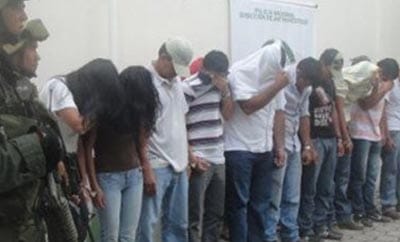Police say two neo-paramilitary organizations have apparently merged forces along Colombia’s Pacific coast, offering insight into the strategy of criminal group the Gaitanistas as they expand in the region.
Authorities arrested 28 suspects in five different towns in the Choco department, including capital city Quibdo. Among the detainees were five municipal police officers. They are accused of forming part of the Gaitanistas, also known as the Gulf Clan, Urabeños, and Gaitanist Self-Defense Forces of Colombia (Autodefensas Gaitanistas de Colombia – AGC), and another criminal organization, known as Renacer (Rebirth).
Authorities say that the AGC bought the support of Renacer in order to better confront rival organization the Rastrojos, the traditional criminal power in the Pacific.
Together, the groups aim to control drug trafficking routes in the region with a focus on Choco’s coastal mountain range of Baudo, according to an anonymous security forces source consulted by El Tiempo.
The investigation also revealed that Renacer has expanded into the mining industry, providing security for mining operations and setting up front companies that sell precious metals, as a way to launder money.
The detainees will be charged with forced displacement, drug trafficking, and homicide.
InSight Crime Analysis
The news that Renacer is working with the AGC contradicts the latest report by Bogota think tank Nuevo Arco Iris, which suggested Renacer had been absorbed by the Rastrojos.
It could be that the group has splintered into factions, each seeking their own alliance, or it could be that either Nuevo Arco Iris or the police are mistaken. Either way, this apparent alliance between Renacer and the AGC reflects a larger trend in the Colombian underworld.
Renacer was one of an estimated 33 criminal groups that emerged post-2006, following the failed demobilization of paramilitary group the United Self-Defense Forces of Colombia (AUC), and the breakup of the Norte Del Valle cartel.
By the latest police estimate, only five of these 33 groups remain active. While the government has trumpeted this as a sign of its success in the battle against the criminal organizations they call the BACRIM (“bandas criminales,” or criminal bands), Nuevo Arco Iris has argued it is instead a sign of the convergence of small criminal networks around Colombia’s two main groups, the AGC and the Rastrojos.
This phenomenon — in which smaller, local criminal groups merge with large, transnational organizations — has proven beneficial to both sides. The bigger cartels gain foot soldiers, and access to local knowledge, contacts, and trafficking routes, while the smaller groups gain the patronage, financial support, and armed backing of powerful transnational organizations.
If it is true that Renacer are now fighting the Rastrojos alongside the AGC, then this further strengthens the AGC push into the Pacific region. Renacer is not the first group co-opted by the AGC along the Pacific coast. In Valle del Cauca department, the AGC are known to have bought out the remnants of the Machos, who are also long-time enemies of the Rastrojos. Altogether, the AGC appear to be building a formidable coalition in their attempts to dislodge the Rastrojos from their Pacific stronghold.

